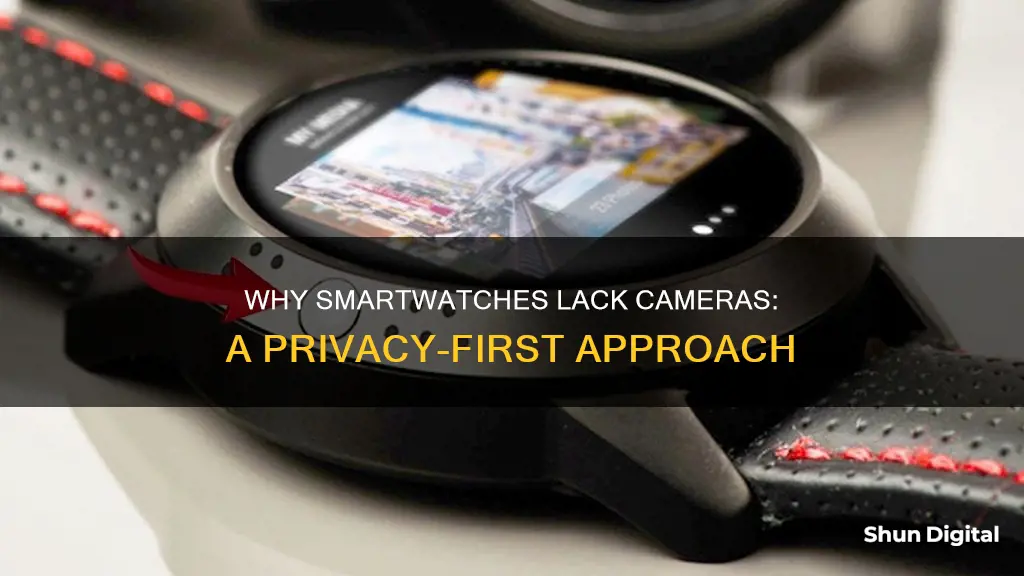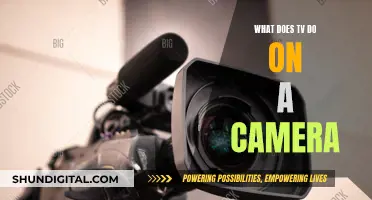
Smartwatches have become increasingly popular as wearable devices that offer various features and functionalities. One common question that arises is whether smartwatches have cameras. The answer is that it depends on the brand and model of the smartwatch. While some smartwatches on the market do feature cameras, others, like the Apple Watch, do not. Smartwatches with cameras can be a convenient way to capture memories on the go, take quick photos of documents or presentations, and offer a more discreet way to take photos and videos compared to smartphones. However, there are also some drawbacks to consider, such as shorter battery life, potential privacy concerns, and varying image quality. Additionally, some smartwatches can be used as a camera remote to control your phone's camera shutter.
| Characteristics | Values |
|---|---|
| Smartwatches with cameras exist | Yes, but they are rare. |
| Smartwatches with cameras are useful | Yes, but they add bulk and reduce battery life. |
| Smartwatches can be used as camera remotes | Yes, some have this feature built-in, while others require a third-party app. |
What You'll Learn
- Smartwatches can be used as a camera remote to control your phone's camera shutter
- Some smartwatches have a built-in camera app, while others require a third-party app
- Smartwatches with cameras can take decent photos and videos, but the quality varies by model
- Smartwatches with cameras may have shorter battery life due to the extra processing power required
- Privacy and societal implications: smartwatch cameras may enable creepshots and make it difficult to know when you're being filmed or photographed

Smartwatches can be used as a camera remote to control your phone's camera shutter
Smartwatches are increasingly becoming more than just a fitness gadget or a way to discreetly view notifications. While not all smartwatches have built-in cameras, they can be used as camera remotes to control your phone's camera shutter. This allows you to take photos without touching your phone and can be especially useful when taking group photos or selfies.
The Apple Watch, for example, has a built-in camera remote app that allows you to control the camera on your iPhone. You can use your watch as a viewfinder, review photos, and adjust settings like the timer, flash, HDR, and Live Photo. Similarly, Samsung's Galaxy Watch 4 and Watch 4 Classic have the Camera Controller app preloaded, which enables you to review photos, use the watch as a viewfinder, set timers, and choose between the front and rear cameras.
For Wear OS watches, if your watch is paired with a Pixel phone, you can download the Google Camera app to enable the camera remote feature. This app is also compatible with non-Samsung Wear OS watches, but it won't work with non-Pixel Android phones. Additionally, third-party apps are available for smartwatches like Garmin, Fitbit, and non-Samsung Wear OS watches that are not paired with a Pixel phone. These apps often offer features like taking selfies, group photos, recording audio, and saving photos onto your watch or an SD card.
While using your smartwatch as a camera remote, it's important to ensure that your watch and phone are connected, and you may need to adjust your phone's display settings to keep the screen from turning off while taking pictures. Additionally, keep in mind that Bluetooth is typically how smartwatches communicate with your phone, so you'll need to be within Bluetooth range for the camera remote feature to work.
PennDOT Cameras: Live Access and Availability for Viewers
You may want to see also

Some smartwatches have a built-in camera app, while others require a third-party app
Smartwatches with cameras are available, but not all models have this feature. Some smartwatches have a built-in camera app, while others require a third-party app.
The Apple Watch, for example, does not have a built-in camera. However, users can purchase a Wristcam, a smart band with external and internal cameras that can be used for video calling and taking photos and videos. The Wristcam is integrated into the Apple Watch, and images and videos are automatically uploaded to the iPhone's photo gallery when the watch is charging.
There are also several Android-compatible smartwatches with built-in cameras available on the market, such as the Refly 4G Smartwatch, the Padgene DZON Smartwatch, and the Amokeoo Smartwatch. These watches often include additional features such as fitness tracking, social media integration, and expandable storage. However, it's important to note that the camera quality can vary, with megapixel ratings ranging from 0.3 to eight or more.
For those looking for a smartwatch with a camera for kids, options like the Xplora XGO3 and the Bauisan Kids Smartwatch offer a 2-megapixel camera, step counter, and parental controls through a companion app.
How ADT Monitors Your Security Cameras
You may want to see also

Smartwatches with cameras can take decent photos and videos, but the quality varies by model
Smartwatches with cameras can take photos and videos, with the quality varying by model. Some watches have basic camera capabilities, while others offer higher-quality images and videos.
The Refly 4G Smartwatch, for instance, features a five-megapixel camera, while the Padgene DZON Smartwatch has a 0.3-megapixel camera. The Rainbuvvy DM101 smartwatch stands out with its high-resolution eight-megapixel front camera and two-megapixel side camera. The Zeblaze Thor 4 Dual Smartwatch offers a mid-range five-megapixel camera.
It's worth noting that some smartwatches, like the Apple Watch, don't have built-in cameras but can be used with external camera devices like the Wristcam.
When considering a smartwatch with a camera, it's important to look beyond just camera quality. Other factors to consider include battery life, ease of use, design, and compatibility with your smartphone's operating system. Additionally, certain features, such as video calling or remote camera control, may be considered premium functions and are not available on all models.
Smartwatches with cameras can be a convenient way to capture moments when you don't have your phone, but they may not replace dedicated cameras or smartphones for more professional or detailed photography.
Apple's Watchful Eye: Camera Surveillance Concerns
You may want to see also

Smartwatches with cameras may have shorter battery life due to the extra processing power required
Smartwatches with built-in cameras are not very common, and there are several reasons for this. One of the main concerns is battery life. A camera would require extra processing power, which could result in shorter battery life for the device. This is a significant consideration, as smartwatches already have a limited battery capacity, and adding a camera could further reduce the time between charges.
The Wristcam, a smart band accessory for the Apple Watch, provides an example of the impact of camera usage on battery life. The Wristcam's camera has a battery life of around 8 to 10 hours with continuous use, and the device itself adds bulk to the watch. While it offers the convenience of hands-free video calling and taking photos and videos without a phone, the trade-off is a shorter overall battery life for the smartwatch.
Additionally, the processing power required for a camera on a smartwatch may impact the device's performance. The limited processing power of smartwatches means that the addition of a camera could affect the speed and responsiveness of the device. This could result in a sluggish user experience, with potential delays in capturing and processing images.
The impact on battery life and device performance are crucial factors in the decision to include a camera in a smartwatch. While some users may find the addition of a camera convenient, the trade-offs in terms of reduced battery life and potential performance issues are significant considerations. As a result, smartwatch manufacturers have to carefully weigh the benefits of including a camera against the potential drawbacks, especially since one of the main selling points of smartwatches is their compact size and convenience.
While some smartwatches on the market do offer built-in cameras, such as certain older Samsung models, the majority of popular smartwatches like the Apple Watch and newer Samsung models do not include this feature. Instead, they focus on other functionalities and rely on connected smartphones for more advanced tasks.
Pixel Watch: Camera Expectations and Realities
You may want to see also

Privacy and societal implications: smartwatch cameras may enable creepshots and make it difficult to know when you're being filmed or photographed
Smartwatches with cameras pose a number of privacy and societal concerns. One of the main issues is that they may enable creepshots and make it difficult for individuals to know when they are being filmed or photographed. This could have a significant impact on people's privacy and sense of security, especially in public spaces.
Smartwatch cameras, due to their small and discreet form factor, can be easily hidden and used to capture photos or videos without the knowledge or consent of those being recorded. This could lead to an invasion of privacy and potentially facilitate inappropriate or illegal activities such as voyeurism or stalking. The surreptitious nature of smartwatch cameras makes it challenging for individuals to detect when they are being recorded, compromising their privacy and sense of security.
Additionally, the always-on nature of smartwatches with cameras could lead to constant surveillance and monitoring of individuals without their consent. This raises serious privacy concerns, as personal moments or private activities could be inadvertently captured and potentially misused. The ease of sharing and distributing content captured on smartwatches further exacerbates these concerns, as individuals may find themselves unknowingly exposed to a wider audience.
Another concern is the potential for misuse of smartwatch cameras by unauthorized users. If a smartwatch is lost, stolen, or accessed by an unauthorized individual, the camera could be used to compromise the privacy and security of others. This could include capturing sensitive or confidential information, or invading the privacy of individuals in changing rooms, restrooms, or other private spaces.
Furthermore, the integration of cameras into smartwatches could lead to a normalization of constant recording and surveillance. This could have a detrimental effect on societal norms and expectations of privacy. Individuals may feel pressured to allow constant recording in certain spaces or during specific activities, even if they are uncomfortable with it. This shift in societal norms could have far-reaching implications for privacy and personal freedom.
While smartwatch cameras offer certain benefits, such as convenience and security, it is important to carefully consider the potential implications for privacy and society as a whole. Striking a balance between technological advancement and protecting individual privacy rights is crucial to ensure a safe and respectful environment for all.
Galaxy Watch 3: Camera Expectations and Realities
You may want to see also
Frequently asked questions
Smartwatches with cameras have proven to be a privacy nightmare, as it would be difficult to know when someone is recording or taking a photo.
Yes, Samsung's first smartwatch, the Galaxy Gear, featured a camera. However, the quality of the photos and videos was questionable, and it was bulky and had poor battery life.
A camera on a smartwatch can be convenient when you don't have your phone with you.
Yes, you can take photos with a smartwatch that has a camera by opening the camera app and framing your shot. You can then transfer the photos to your phone via Bluetooth, Wi-Fi, or cloud storage.







